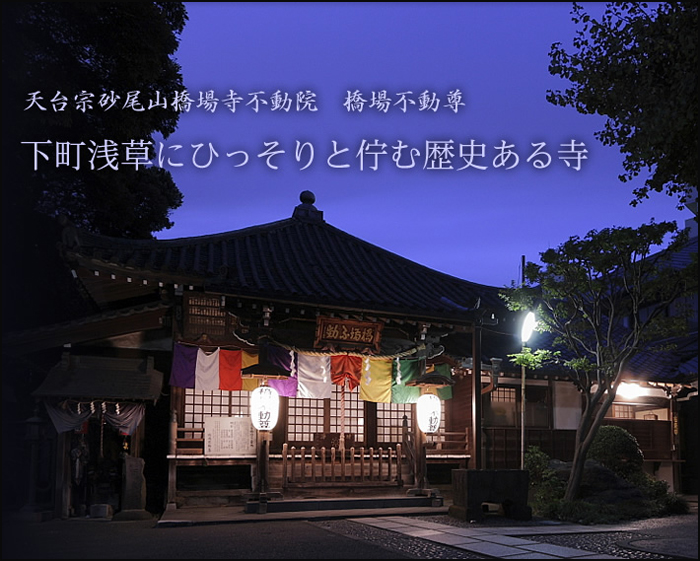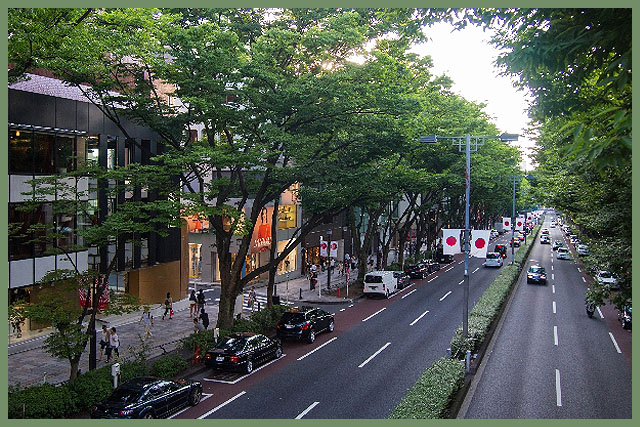https://edoflourishing.blogspot.com/2018/07/hashiba-district-taito.html
[ . BACK to DARUMA MUSEUM TOP . ]
. Famous Places and Powerspots of Edo 江戸の名所 .
::::::::::::::::::::::::::::::::::::::::::::::::::::::::::::::::::::::::::::::::::::::::::::::::::::::::::::::::::::::::::::::::::::::::::::::::::::::::::::::::::::::::::::::::::::
Hashiba 橋場 Hashiba district, "place with a bridge"
台東区 Taito ward, 橋場一丁目及び橋場二丁目 Hashiba first and second sub-district
In the North-East of Taito ward.

The river crossing of the river Sumidagawa was already known in the Heian period.
In the Edo period, this district was called
Asakusa Hashiba machi 浅草橋場町
The name implies that there must have been a bridge in former times.
The bridge might have been constructed by 太田道灌 Ota Dokan. Some remains of the wooden piles were found later.
. 太田道灌 Ota Dokan (1432 - 1486) .
In 1913, the oldest crossing of the river Sumidagawa、 橋場の渡し Hashiba no watashi was designated.
In 1964, the local people decided to give the name of Hashiba to the whole district along the West side of the river.
. Sumidagawa 隅田川 River Sumidagawa in Edo .
..............................................................................................................................................
- source : National Diet Library -
Hiroshige 広重 and Sumidagawa Hashiba - Imado
Taito-ku, Imado / Hashiba
- - - - - Description
The area from Imado-bashi Bridge to Kanegafuchi on the right bank of the Sumida-gawa River. It is noted in the "Gikeiki" (a military epic about the life of Yoshitsune) and the "Genpei Seisuiki" (The Rise and Decline of the Minamoto and Taira Clans) that there was a floating bridge at Hashiba, and that is said to be the origin of the name.
The Hashiba ferry linked the present day Hashiba 2 chome with Sumida Ward Tsutsumi-dori Road.
A new port was opened in Imado while an old port existed in nearby Ishihama, and it is thought the name Imazu (current port) became linguistically corrupted to Imado.
Imado Ware (dolls, tiles, etc.) were one of Edo's meibutsu (famous products), and the kilns and smoke of Imado Ware being baked were often pictured in nishiki-e.
.......................................................................

橋場 暮雪 Twilight Snow at Hashiba
.......................................................................

橋場雪中 Hashiba in Snow
江戸自慢三十六興 Edo Jiman Sanjurokukyo
.......................................................................

墨田河橋場の渡かわら竈 Sumida-gawa Hashiba no kawaragama
名所江戸百景 Meisho Edo hyakkei
.......................................................................

隅田川橋場渡之図 Sumida-gawa Hashiba no watashi no zu
江戸高名会亭尽 Edo Komei kaitei zukushi
.......................................................................
- - - - - and
. Sumida-gawa hakkei 隅田川八景 Eight Views from Sumidagawa .
.......................................................................
. Imado Shrine 今戸神社 Imado jinja .
:::::::::::::::::::::::::::::::::::::::::::::::::::::::::::::::::::::::::::::::::::::::::::::::::::::::::::::::::::::::::::::::::::::::::::::::::::::::::::::::::::::::::::::::::::
. Comparison of Menus (御料理献立競 Oryori Kondate Kurabe) .
Since the beginning of the Bunka/Bunsei eras (1804 - 1830), many ranking lists that give an insight into the food culture in Edo in those days were published. This ranking is one of them, with Tagawa-ya, a famous catering restaurant in front of Daion-ji temple (in Ryūsen, Taitō ward) as the top-ranked restaurant in the east, and Kawaguchi, a Japanese style luxury restaurant in Hashiba (in Taitō ward) as the top in the west.
Hashiba was an elegant place along the Sumida river with many vacation houses of wealthy merchants and luxury Japanese restaurants.
- source : library .metro. tokyo.
::::::::::::::::::::::::::::::::::::::::::::::::::::::::::::::::::::::::::::::::::::::::::::::::::::::::::::::::::::::::::::::::::::::::::::::::::::::::::::::::::::::::::::::::::::

Hashibaji Fudo-In 橋場寺不動院 Temple Hashiba-Ji Fudo-In
2 Chome-14-19 Hashiba, Taitō, Tokyo 111-0023
- quote -
Hashiba-fudo-son 橋場不動尊 was founded in the fourth year of Hoji era(760) in Tempyo period. In march of the first year of chokan (1163) the temple, which had belonged to the Hosso sect was reorganized by Kyoenbo into the Tendai sect and became a department of Sensoji temple.
According to tradition,
a high priest created the principal image of Fudo-myoo, Roben-sojo (who is also known as the creator of the Daibutsu in Nara) as one of triplet-born images carved from same wood. One of Them has been preserved in Oyama temple of Soshu (present Kanagawa prefecture) and is familiar by the name of Oyama-Fudo.
Roben carved three identical images of Fudo-son,
Leaving one of them to Oyama-dera, the second to himself and the third to his best disciple, Jakusho-shonin. In the forth year of Hoki (773), which was the Year Roben passed away, on his way to Kazusa(present Chiba prefecture) Jakusho happened to be here to be inspired by Buddha with the idea that this should be the place to enshrine the image. He constructed a small shrine, which he named Sunao-Fudo-son.
For 1,250 years local peasants have worshiped it and since the temple attained an image of Yakushi-Nyorai, which is supposed to be the creation of Eshin-sozu, it has also been called Sunao-Yakushi.
The present head-priest, Kamiya Ryoshu is the hundredth successor of Hashiba-Fudo-son.
- HP of the temple
- reference source : www.fudoin.jp... -
. 関東三十六不動霊場 Pilgrimage to 36 Fudo Temples in Kanto .
Hashiba Fudo-In is Nr. 23
. Rooben Soojoo 良弁僧正 Roben Sojo (689 - 773) .
::::::::::::::::::::::::::::::::::::::::::::::::::::::::::::::::::::::::::::::::::::::::::::::::::::::::::::::::::::::::::::::::::::::::::::::::::::::::::::::::::::::::::::::::::::
. Legends and Tales from Japan 伝説 - Introduction .
................................................................................. Arakawa 荒川区
. kitsune densetsu 狐と伝説 fox legends .
Oide Kitsune, Oidegitsune 御出狐 the Fox Oide and the shrine おいで稲荷 Oide Inari
Around 1780 there lived an old woman in the tea stall at 真崎稲荷 Masaki Inari shrine, who was friends with a fox. When the woman called
"Oide おいで Come here, come here!"
the fox came to look at her and was thus called Oidegitsune.
The fox later bewitched the daughter of the old woman and told her it had to go home to its hometown in Northern Japan.
As a memento the fox left a hand fan with a poem on the bench of the tea stall and was not seen again.

In the back of Masaki Inari is the Oide Inari shrine. People make a wish and offerings of 油揚 Abura-age Tofu in the evening and if the offering is gone next morning, their with will be granted.
Oide Inari 「招来(おいで)稲荷」
.......................................................................
The mystery ofthe Shinto shrines 真崎稲荷 Masaki Inari and 石浜神社 Ishihama Jinja
There are two names for the same shrine located at
真先稲荷 東京都荒川区南千住 3-28-58 / 3 Chome-28-58 Minami-Senju, Arakawa ward

Close to the shrine was the Hashiba crossing of the river Sumidagawa.
石浜神社 Ishihama Jinja
東京都荒川区南千住3-28-58 / 3 Chome-28-58 Minamisenju, Arakawa ward

- HP of Ishihama Jinja
- reference source : ishihamajinja.jp... -
..............................................................................................................................................
- reference : nichibun yokai database -
::::::::::::::::::::::::::::::::::::::::::::::::::::::::::::::::::::::::::::::::::::::::::::::::::::::::::::::::::::::::::::::::::::::::::::::::::::::::::::::::::::::::::::::::::::

- - - To join me on facebook, click the image !
:::::::::::::::::::::::::::::::::::::::::::::::::::::::::::::::::::::::::::::::::::::::::::::::::::::::::::::::::::::::::::::::::::::::::::::::::::::::::::::::::::::::::::::::::::::
. Taitoo, Taitō 台東区 Taito Ward .
. Edo bakufu 江戸幕府 The Edo Government .
. Famous Places and Powerspots of Edo 江戸の名所 .
. Doing Business in Edo - 商売 - Introduction .
. shokunin 職人 craftsman, craftsmen, artisan, Handwerker .
. senryu, senryū 川柳 Senryu poems in Edo .
. Japanese Architecture - The Japanese Home .
. Interior Design - The Japanese Home .
. Legends and Tales from Japan 伝説 - Introduction .
[ . BACK to DARUMA MUSEUM TOP . ]
[ . BACK to WORLDKIGO . TOP . ]
- - - - - #hashiba #hashibataito - - - -
:::::::::::::::::::::::::::::::::::::::::::::::::::::::::::::::::::::::::::::::::::::::::::::::::::::::::::::::::::::::::::::::::::::::::::::::::::::::::::::::::::::::::::::::
Hashiba district Taito
. Famous Places and Powerspots of Edo 江戸の名所 .
::::::::::::::::::::::::::::::::::::::::::::::::::::::::::::::::::::::::::::::::::::::::::::::::::::::::::::::::::::::::::::::::::::::::::::::::::::::::::::::::::::::::::::::::::::
Hashiba 橋場 Hashiba district, "place with a bridge"
台東区 Taito ward, 橋場一丁目及び橋場二丁目 Hashiba first and second sub-district
In the North-East of Taito ward.

The river crossing of the river Sumidagawa was already known in the Heian period.
In the Edo period, this district was called
Asakusa Hashiba machi 浅草橋場町
The name implies that there must have been a bridge in former times.
The bridge might have been constructed by 太田道灌 Ota Dokan. Some remains of the wooden piles were found later.
. 太田道灌 Ota Dokan (1432 - 1486) .
In 1913, the oldest crossing of the river Sumidagawa、 橋場の渡し Hashiba no watashi was designated.
In 1964, the local people decided to give the name of Hashiba to the whole district along the West side of the river.
. Sumidagawa 隅田川 River Sumidagawa in Edo .
..............................................................................................................................................
- source : National Diet Library -
Hiroshige 広重 and Sumidagawa Hashiba - Imado
Taito-ku, Imado / Hashiba
- - - - - Description
The area from Imado-bashi Bridge to Kanegafuchi on the right bank of the Sumida-gawa River. It is noted in the "Gikeiki" (a military epic about the life of Yoshitsune) and the "Genpei Seisuiki" (The Rise and Decline of the Minamoto and Taira Clans) that there was a floating bridge at Hashiba, and that is said to be the origin of the name.
The Hashiba ferry linked the present day Hashiba 2 chome with Sumida Ward Tsutsumi-dori Road.
A new port was opened in Imado while an old port existed in nearby Ishihama, and it is thought the name Imazu (current port) became linguistically corrupted to Imado.
Imado Ware (dolls, tiles, etc.) were one of Edo's meibutsu (famous products), and the kilns and smoke of Imado Ware being baked were often pictured in nishiki-e.
.......................................................................

橋場 暮雪 Twilight Snow at Hashiba
.......................................................................

橋場雪中 Hashiba in Snow
江戸自慢三十六興 Edo Jiman Sanjurokukyo
.......................................................................

墨田河橋場の渡かわら竈 Sumida-gawa Hashiba no kawaragama
名所江戸百景 Meisho Edo hyakkei
.......................................................................

隅田川橋場渡之図 Sumida-gawa Hashiba no watashi no zu
江戸高名会亭尽 Edo Komei kaitei zukushi
.......................................................................
- - - - - and
. Sumida-gawa hakkei 隅田川八景 Eight Views from Sumidagawa .
.......................................................................
. Imado Shrine 今戸神社 Imado jinja .
:::::::::::::::::::::::::::::::::::::::::::::::::::::::::::::::::::::::::::::::::::::::::::::::::::::::::::::::::::::::::::::::::::::::::::::::::::::::::::::::::::::::::::::::::::
. Comparison of Menus (御料理献立競 Oryori Kondate Kurabe) .
Since the beginning of the Bunka/Bunsei eras (1804 - 1830), many ranking lists that give an insight into the food culture in Edo in those days were published. This ranking is one of them, with Tagawa-ya, a famous catering restaurant in front of Daion-ji temple (in Ryūsen, Taitō ward) as the top-ranked restaurant in the east, and Kawaguchi, a Japanese style luxury restaurant in Hashiba (in Taitō ward) as the top in the west.
Hashiba was an elegant place along the Sumida river with many vacation houses of wealthy merchants and luxury Japanese restaurants.
- source : library .metro. tokyo.
::::::::::::::::::::::::::::::::::::::::::::::::::::::::::::::::::::::::::::::::::::::::::::::::::::::::::::::::::::::::::::::::::::::::::::::::::::::::::::::::::::::::::::::::::::

Hashibaji Fudo-In 橋場寺不動院 Temple Hashiba-Ji Fudo-In
2 Chome-14-19 Hashiba, Taitō, Tokyo 111-0023
- quote -
Hashiba-fudo-son 橋場不動尊 was founded in the fourth year of Hoji era(760) in Tempyo period. In march of the first year of chokan (1163) the temple, which had belonged to the Hosso sect was reorganized by Kyoenbo into the Tendai sect and became a department of Sensoji temple.
According to tradition,
a high priest created the principal image of Fudo-myoo, Roben-sojo (who is also known as the creator of the Daibutsu in Nara) as one of triplet-born images carved from same wood. One of Them has been preserved in Oyama temple of Soshu (present Kanagawa prefecture) and is familiar by the name of Oyama-Fudo.
Roben carved three identical images of Fudo-son,
Leaving one of them to Oyama-dera, the second to himself and the third to his best disciple, Jakusho-shonin. In the forth year of Hoki (773), which was the Year Roben passed away, on his way to Kazusa(present Chiba prefecture) Jakusho happened to be here to be inspired by Buddha with the idea that this should be the place to enshrine the image. He constructed a small shrine, which he named Sunao-Fudo-son.
For 1,250 years local peasants have worshiped it and since the temple attained an image of Yakushi-Nyorai, which is supposed to be the creation of Eshin-sozu, it has also been called Sunao-Yakushi.
The present head-priest, Kamiya Ryoshu is the hundredth successor of Hashiba-Fudo-son.
- HP of the temple
- reference source : www.fudoin.jp... -
. 関東三十六不動霊場 Pilgrimage to 36 Fudo Temples in Kanto .
Hashiba Fudo-In is Nr. 23
. Rooben Soojoo 良弁僧正 Roben Sojo (689 - 773) .
::::::::::::::::::::::::::::::::::::::::::::::::::::::::::::::::::::::::::::::::::::::::::::::::::::::::::::::::::::::::::::::::::::::::::::::::::::::::::::::::::::::::::::::::::::
. Legends and Tales from Japan 伝説 - Introduction .
................................................................................. Arakawa 荒川区
. kitsune densetsu 狐と伝説 fox legends .
Oide Kitsune, Oidegitsune 御出狐 the Fox Oide and the shrine おいで稲荷 Oide Inari
Around 1780 there lived an old woman in the tea stall at 真崎稲荷 Masaki Inari shrine, who was friends with a fox. When the woman called
"Oide おいで Come here, come here!"
the fox came to look at her and was thus called Oidegitsune.
The fox later bewitched the daughter of the old woman and told her it had to go home to its hometown in Northern Japan.
As a memento the fox left a hand fan with a poem on the bench of the tea stall and was not seen again.

In the back of Masaki Inari is the Oide Inari shrine. People make a wish and offerings of 油揚 Abura-age Tofu in the evening and if the offering is gone next morning, their with will be granted.
Oide Inari 「招来(おいで)稲荷」
.......................................................................
The mystery ofthe Shinto shrines 真崎稲荷 Masaki Inari and 石浜神社 Ishihama Jinja
There are two names for the same shrine located at
真先稲荷 東京都荒川区南千住 3-28-58 / 3 Chome-28-58 Minami-Senju, Arakawa ward

Close to the shrine was the Hashiba crossing of the river Sumidagawa.
石浜神社 Ishihama Jinja
東京都荒川区南千住3-28-58 / 3 Chome-28-58 Minamisenju, Arakawa ward

- HP of Ishihama Jinja
- reference source : ishihamajinja.jp... -
..............................................................................................................................................
- reference : nichibun yokai database -
::::::::::::::::::::::::::::::::::::::::::::::::::::::::::::::::::::::::::::::::::::::::::::::::::::::::::::::::::::::::::::::::::::::::::::::::::::::::::::::::::::::::::::::::::::

- - - To join me on facebook, click the image !
:::::::::::::::::::::::::::::::::::::::::::::::::::::::::::::::::::::::::::::::::::::::::::::::::::::::::::::::::::::::::::::::::::::::::::::::::::::::::::::::::::::::::::::::::::::
. Taitoo, Taitō 台東区 Taito Ward .
. Edo bakufu 江戸幕府 The Edo Government .
. Famous Places and Powerspots of Edo 江戸の名所 .
. Doing Business in Edo - 商売 - Introduction .
. shokunin 職人 craftsman, craftsmen, artisan, Handwerker .
. senryu, senryū 川柳 Senryu poems in Edo .
. Japanese Architecture - The Japanese Home .
. Interior Design - The Japanese Home .
. Legends and Tales from Japan 伝説 - Introduction .
[ . BACK to DARUMA MUSEUM TOP . ]
[ . BACK to WORLDKIGO . TOP . ]
- - - - - #hashiba #hashibataito - - - -
:::::::::::::::::::::::::::::::::::::::::::::::::::::::::::::::::::::::::::::::::::::::::::::::::::::::::::::::::::::::::::::::::::::::::::::::::::::::::::::::::::::::::::::::






























